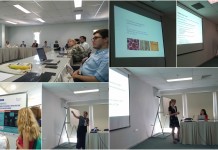Once large scale datasets are more freely available, and support for practitioners is established, the final phase of this roadmap focusses on providing as much of society as possible with the fundamental awareness and skills to pursue TDM technologies, if they so choose. The ‘next generation’ in this context refers not only to younger generations, but to anyone who might become a practitioner or supporter of TDM through acquisition of new skills and knowledge.
Phase III: The Next Generation
OBJECTIVE
Foster a ‘data-savvy’ society through awareness and education in fundamental skills, to broaden the pool of future TDM practitioners and promoters.
SITUATION
Although interest in TDM and data analytics is growing, there are still a great many people who have little concept of what TDM technologies are, let alone how they might benefit a given sector. The general attitude among stakeholders consulted in the FutureTDM project is that over the coming years, data science will become ‘the new IT’, and that it will become critical for all members of society to have some awareness of the uses and impact of data.
By supporting awareness and education in data literacy and related skills, the Commission will pave the way to a ‘data-savvy’ society that will foster future waves of TDM practitioners.
CHALLENGES
In many areas, there is still a lack of awareness of what TDM and data analytics actually are, how they can be used, and what sorts of benefits can be derived from these technologies. Obviously if people are unaware of the potential applications of TDM, they will not think to pursue the use of TDM technologies.
Understanding where TDM technologies may be useful requires a basic level of data literacy – that is, an understanding of what data is, why it is valuable, and how it can be used. At the moment, there is little attention paid to data literacy in education until and unless students choose to pursue computer science or related fields in secondary education or beyond.
This means that students who choose not to explicitly study computer science or related fields are unlikely to be taught the data literacy skills that are becoming more and more fundamental to all sectors of modern society. This in turn puts those from non-technical fields at a disadvantage when it comes to understanding the potential value and applications of TDM technologies.
There are significant economic costs associated with introducing TDM into business and education alike; this is likely to disrupt existing practices and workflows, and require new training and acquisition of staff. Without clear evidence of the economic benefits of using TDM technologies, there is little incentive for either the education system or industry to integrate TDM into their curricula or decision-making processes.
PRINCIPLES
Work still needs to be done to raise awareness of the existence and potential applications of TDM technologies.
Introduce basic data literacy into educational curricula as early as possible, to foster a ‘data-savvy’ society in which citizens in all sectors understand the potential value and uses of data.
Clear examples of the benefits of TDM are needed to incentivise people to invest in training and use of TDM technologies.
ACTIVITIES
To increase awareness of the vast breadth of potential TDM applications, and combat perceptions that TDM is valuable only to technical and quantitative fields, the Commission and projects like FutureTDM should promote examples of TDM being applied in less common fields and sectors. These will help people across all economic sectors to gain a better understanding of what TDM technologies are, the various ways in which they can be used, and ultimately to recognise ways in which TDM may be applied in their own areas.
FutureTDM’s report on the future applications and economics of TDM clearly demonstrates the future economic value of TDM technologies (See FutureTDM D5.2: Trend analysis, future applications and economics of TDM). Investing in education to foster a ‘data-savvy’ society will in turn help nurture the skills that underpin the use of big data, data analytics, and TDM, and ensure that Europe can maximise the potential economic benefits of these areas.
While FutureTDM’s report on the economics of TDM demonstrates the value of investing in TDM to society as a whole, specific examples are needed to demonstrate how businesses can benefit from integrating TDM into their workflows and decision-making. Case studies that show concrete savings in time, money, or other resources should be identified and disseminated to encourage industries to adopt and invest in TDM technologies.
For more information see our Deliverable 5.4 Roadmap for increasing uptake of TDM






